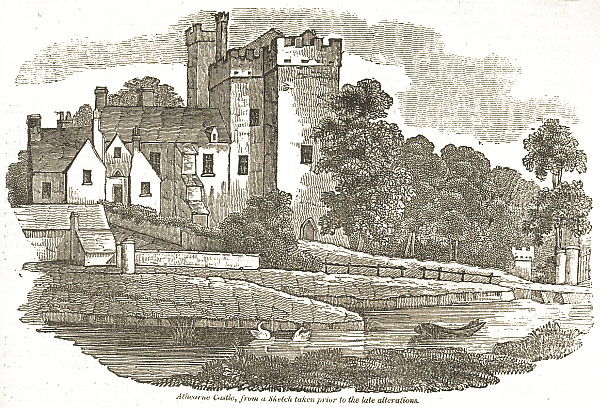Athcarne Castle, County Meath

Of the many fine castles or castellated houses erected by the descendants of the old English settlers of the Pale, one ot the most interesting in several particulars, was that which is the subject of our prefixed illustration; for though of no higher antiquity than the reign of Elizabeth, it preserved, till lately, without change, its original form and character, a peculiarity which bad taste and love of change has rarely permitted our ancient buildings of this class to retain.
This very interesting specimen of Elizabethan architecture is situated in the county of Meath on the Ashbourne new line of road, about 17 miles from Dublin and 5 from Drogheda. It consists of an extensive mansion and a lofty castle, united together, and of co-eval erection, presenting in every point of view a picturesque variety of outline, rarely to be found in modern domestic architecture. The pleasing little river Nanny-water, which nearly washes its base, lends its beauty to the ancient mansion, when is also adorned by traces of equal antiquity and venerable appearance.
From inscriptions which appear over several of the doorways, we find that Athcarne Castle was erected for William Bathe and his wife Janet Dowdal, in the year 1590. This William Bathe was a person of much distinction in his day, and a younger branch of the ancient and respectable family of the name of Knightstown, in the same county, now represented by the worthy Sir William Plunket de Bathe, Bart., who still is in possession of that place, being a part of the original grant to his ancestor in the year 1172, and who has re-assumed, by his Majesty's design manual, the ancient family name of De Bathe, after its having for upwards of three hundred years fallen into disuse.
The Athcarne branch of the family is, we believe, represented by Mr. Joseph Henry Bath of Galway and Dublin, who also represents the Baths' of Bremore Castle, which, to the discredit of the present proprietor, has been recently taken down; but neither of those places are now in the possession of the family. The history of the Athcarne property is, we believe, as follows:—
By the act of settlement, vol. ii. sec. 225, p. 347, A.D. 1662, it was provided that Luke Bath of Ackarne, (Athcarne) amongst several others, “who, or their respective fathers, have eminently suffered for their adhering to the authority of his majesty, or his late father of blessed memory, in this kingdom, against the Nuncio and his party, shall be forthwith restored to their former respective estates, and whereof they, or any of their said fathers were dispossessed by the late usurped power, and be therein settled and quieted in possession to them, and to their heirs respectively, as fully, finally, and beneficially, and with the same advantages, benefits and assurances to all intents and purposes, as the Lord Viscount Netterville, and the Lord Viscount Galmoy, and the rest with them in the Declaration herein before mentioned, ought, by virtue of the said Declaration, and this present act, to be restored to their respective estates, anything to the contrary notwithstanding.”
This Luke Bath was immediately afterwards created a baronet; but notwithstanding all this great favor towards him, it appears by a record in the Roll's office, that on the 10th of February, 1663, (the very next year after the above enactment) by an inquisition post mortem, the jurors, after finding that Athcarne, and several other towns and lands, were the property of James Bath of Athcarne, (the deceased father of Sir Luke,) ‘and who being of the said lands possessed, was since indicted and outlawed of high treason by him committed against his majesty Charles I., in his kingdom of Ireland, by reason whereof, the jurors aforesaid, do find the said premises to be forfeited, to the king's majesty, his heirs and successors, and are now held in custodiam by Sir Luke Bath.”
However, by the subsequent explanatory Act of Settlement, vol. iii. p. 117, A. D. 1665, Sir Luke was restored to, or rather continued in the possession (which he never lost) to the time of his death, in which also, his son, Sir Peter continued to the time of his death: after which, (he having left no male issue) a collusive proceeding took place between the then Duke of York, (afterwards James II.) and Lady Cecilia, the widow of Sir Luke, and Lady Margaret, the widow of Sir Peter, and their trustees, George Aylmer and Launcelot Dowdall, (brother of Lady Cecilia) which collusion was established for the purpose of defeating the rights of the male heir of the Bath family, who being thus despoiled of his right, made, as did also his descendants, at several periods, frequent, but in consequence of their poverty, ineffectual attempts to recover it.
The property was sold at Chichester-house, in the year 1703, to Mr. S——e, a woollen-draper in High-street, Dublin, (subject however, to the lease of 99 years, allowed in 1700, in the Court of Claims, executed by the Duke of York to the above trustees, at a pepper-corn rent!) for a sum of £430.
The counties of Meath and Louth are rich in antiquarian remains of this respectable family. In a former number we gave a view of their beautiful wooden house in Drogheda, and we shall in future numbers give illustrations of several of the magnificent votive stone crosses erected in various parts of the country to the memory of William Bathe of Athcarne, by his widow, and which are the finest monuments of their kind now remaining in Ireland.
P.
